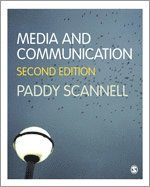
- Format
- Inbunden (Hardback)
- Språk
- Engelska
- Antal sidor
- 360
- Utgivningsdatum
- 2020-10-19
- Upplaga
- 2
- Förlag
- SAGE Publications Ltd
- Dimensioner
- 234 x 188 x 25 mm
- Vikt
- Antal komponenter
- 1
- ISBN
- 9781446297070
- 794 g
Media and Communication
- Skickas från oss inom 5-8 vardagar.
- Fri frakt över 249 kr för privatkunder i Sverige.
Passar bra ihop
De som köpt den här boken har ofta också köpt Who's Afraid of Gender? av Judith Butler (inbunden).
Köp båda 2 för 1824 krKundrecensioner
Fler böcker av Paddy Scannell
-
A Social History of British Broadcasting
Paddy Scannell, David Cardiff
-
Radio, Television and Modern Life
Paddy Scannell
-
Television and the Meaning of 'Live'
Paddy Scannell
-
Why Do People Sing?
Paddy Scannell
Recensioner i media
This is a lucid, generous, and strikingly original account of the emergence of media and communication studies as a vibrant academic field. Moving across sociology, critical theory, and cultural studies, Scannell takes stock of the key concepts and questions that have come to define the field over the past six decades. In this expanded and revised edition, Scannell identifies what is distinctive about the media of the 20th century - the immense power of live broadcasting and unscripted talk in public in shaping both the eventful and the everyday across much of the world. The result is a milestone intellectual history of media and communication studies that sets the conceptual coordinates for our digital present and future.
Anyone who wants to understand the intellectual roots of the present study of media and communication needs to read this book. Scannell’s achievement is quite unique: he puts the American, the European and the British traditions of inquiry into productive dialogue with each other and shows some surprising affinities between them as well as some prescient foresights. The breadth of his scholarship is invariably enlightening, lucid in its accounts and generous in its judgements.
Övrig information
Paddy Scannell worked for many years at the University of Westminster (London) where he and his colleagues established, in 1975, the first undergraduate degree program in Media Studies in the UK. He is a founding editor of Media, Culture and Society which began publication in 1979 and is now issued six times yearly. He is the author of A Social History of British Broadcasting, 1922-1939 which he wrote with David Cardiff, editor of Broadcast Talk and author of Radio, Television and Modern Life. He is currently working on a trilogy. The first volume, Media and Communication, was published in June 2007. Professor Scannell is now working on the second volume, Television and the Meaning of 'Live.' The third volume, Love and Communication, is in preparation. His research interests include broadcasting history and historiography, the analysis of talk, the phenomenology of communication and culture and communication in Africa.
Innehållsförteckning
Part I The masses 1. Mass communication: Lazarsfeld, Adorno, Merton, USA, 1930s and 1940s 2. Mass culture: Horkheimer, Adorno, Brecht, Benjamin, Germany/USA, 1930s and 1940s 3. The end of the masses: Merton, Lazarsfeld, Riesman, Katz, USA, 1940s and 1950s Part II Everyday life 4. Culture and communication: Leavis, Hoggart, Williams, England, 1930s-1950s 5. Communication and technology: Innis, McLuhan, Canada, 1950s-1960s 6. Communication as interaction: Goffman and Garfinkel, USA, 1950s-1970s Part III Communicative rationality and irrationality 7. Communication and language: Austin, Grice, Sacks, Levinson, UK/USA, 1950s-1970s 8. Communication as ideology: Hall, UK, 1960s and 1970s 9. Communication and Publicness: Habermas, Germany (USA/UK), 1950s-1990s 10. Media events Conclusion Afterword (2020) Index


